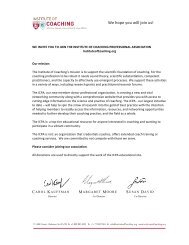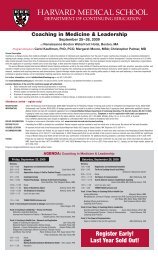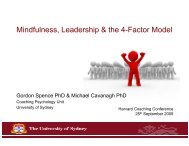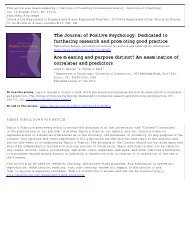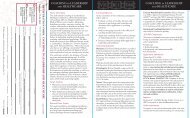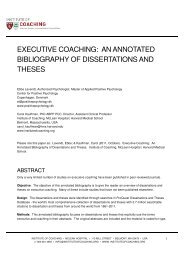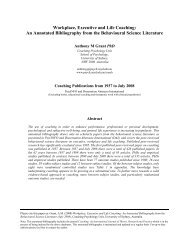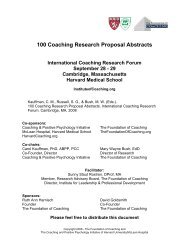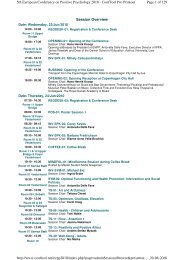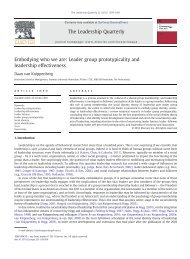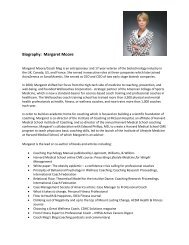Link to slides. - Institute of Coaching
Link to slides. - Institute of Coaching
Link to slides. - Institute of Coaching
- No tags were found...
Create successful ePaper yourself
Turn your PDF publications into a flip-book with our unique Google optimized e-Paper software.
Organize Your Mind <strong>to</strong> ThriveMargaret Moore, MBACo-Direc<strong>to</strong>r<strong>Institute</strong> <strong>of</strong> <strong>Coaching</strong>McLean Hospital, anaffiliate <strong>of</strong> HarvardMedical SchoolCEOWellcoaches Corporation1
A mind once stretched by a new idea…… or newunderstanding willnever fully return <strong>to</strong> itsoriginal dimensions....William James(1842-1910)2
3Our brains learn by making new connections
Lasting change – imagine a new brain network4
The ideal mind/brain?■ Nourished■ Calm■ Zestful■ Positive■ Motivated■ Focused■ Confident■ Creative■ Resilient■ Connected5
Rules <strong>of</strong> OrderSweep your brain clean◘ Tame frenzy◘ Sustain focus◘ Manage distractions6
Rules <strong>of</strong> OrderGet above the forest <strong>to</strong> the big picture◘ Harness working memory◘ Generate leaps <strong>of</strong> insight◘ Connect the dots7
What is frenzy in the brain?■ Negative emotions arising from the limbicsystem which intrude and impair functioning<strong>of</strong> the pre-frontal cortex
Inside frenzy◘ Overwhelm◘ Worry◘ Anxiety◘ Sadness◘ Frustration◘ Irritability◘ Impatience◘ Anger◘ FatigueInner Critic frenzy is particularly harsh.9
Outside frenzy10
Frenzy gets in the way <strong>of</strong> focus■ Internal or external■ Big or small11
Tame frenzy – self-awareness - NAME◘ Gently s<strong>to</strong>p and name the emotion◘ Like a child that cries, the emotion isasking for attention◘ Naming an emotion enables the pre-frontalcortex <strong>to</strong> notice the emotion and let it go12
Self-compassion <strong>to</strong> tame frenzy13
Tame frenzy – self-awareness - APPRAISE◘ Appraise whether the emotional state isa valid one – are you over-reacting?◘ Engage the thinking areas, the areas <strong>of</strong>cognitive control (e.g. pre-frontal cortex)14
Overwhelm is a choice15
Tame frenzy: Increase positive emotions◘ Past – gratitude, forgiveness, silver linings◘ Present – savor, flow, purpose, connect◘ Future – vision, hope, optimism16
Tame frenzy: Engage heart, lungs, musclesBuild new habits which bring calm:◘ Exercise◘ Meditate◘ Mindfulness practices◘ Breathe◘ Sleep17
Attention in the brain◘ Key component <strong>of</strong> Executive Function◘ Pre-frontal cortex, Anterior cingulate cortex◘ Normal attention capacity ~ one hour◘ ADHD ~ “minutes..seconds..what was thequestion?”18
Conscious thinking/doingConsciously manipulate information in your workingmemory <strong>to</strong> solve a problem. State <strong>of</strong> purposeful planningthat comprises much <strong>of</strong> our daily consciously-directedmental activity. You are “thinking” about something.19
Creative Flow StateHighAnxietyArousalFlowChallengesWorryControlLowApathyBoredomSkillsRelaxationHigh20
FlowThoughts and actions begin <strong>to</strong> flow in a steadyharmonious sequence, almost as if they wereorchestrated by outside forces.21
Sustain focus◘ Mindful pause◘ Tell your brain why it matters◘ Practice22
Brain Breaks◘ Everything in moderation◘ Recharge your brain23
Apply the brakes: S<strong>to</strong>p/go paths in the brain◘ The brain has pathways for s<strong>to</strong>p and go◘ Effective inhibition is:• a key component <strong>to</strong> executive function• ? the fundamental deficit in ADHD24
Apply the brakes (impulses, distractions)◘ Tune in<strong>to</strong> emotional response <strong>to</strong>distraction, what need is calling <strong>to</strong> be met◘ Have a head <strong>to</strong> heart conversation25
Apply the brakes (impulses, distractions)◘ ABC – Awareness, Breathe, Choose◘ Consciously choose betweenCamp Spontaneity and Camp Sobriety26
Short-term memory + attention◘ The brain can hold a variety <strong>of</strong> things inshort-term memory◘ The brain uses short-term memory foranalysis, problem-solving, and creativity27
How <strong>to</strong> harness working memory◘ Sleep and rest (sleep on it)◘ Exercise◘ Repetition◘ Write things down by hand◘ Journal◘ Brain training28
Harness working memory◘ Have a reasoned debate◘ Go back & forth between CNN and FoxNews, or New York Times and Wall StreetJournal29
Harness working memory◘ Two heads are better than one◘ Get a partner or coach!30
The flexible brain◘ No multi-tasking◘ Deep focus, leaping <strong>to</strong> another deep focus31
Set shifting – cognitive flexibility◘ Get light on your cognitive feet◘ Bust your silos32
Brains<strong>to</strong>rmEnter a defocused state <strong>of</strong> attention that allows you <strong>to</strong>see the connections between objects or concepts thatare quite disparate in nature. You generate multiplesolutions <strong>to</strong> a given problem rather than focusing on asingle solution.33
The brain – making connections34
Connect the dots◘ New ideas and perspectives emergefrom the combination <strong>of</strong> sustained focus,working memory, set shifting,brains<strong>to</strong>rming35
Rise <strong>to</strong> the big picture◘ The clouds clear and the big pictureappears!36
What’s your first step?• Tame frenzy• Improve focus and flow• Manage distractions & impulses• Harvest working memory• Be cognitively agile• Connect the dots
How does my brain work best?One’s own self is well hidden fromone’s own self:Of all mines <strong>of</strong> treasure, one’s own isthe last <strong>to</strong> be dug up.- Friedrich Nietzsche38



